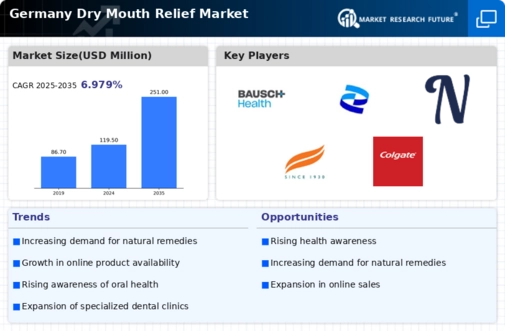Growing Aging Population
The aging population in Germany is a crucial driver for the dry mouth-relief market. As individuals age, they often experience a decline in saliva production, leading to dry mouth, or xerostomia. This condition affects approximately 30% of older adults, creating a substantial demand for dry mouth-relief products. The increasing number of elderly individuals, projected to reach 23% of the total population by 2030, suggests a growing market for solutions addressing this issue. Consequently, manufacturers are likely to focus on developing specialized products tailored to the needs of older consumers, thereby expanding their market presence. The dry mouth-relief market must adapt to these demographic changes to meet the rising demand for effective treatments.
Increased Focus on Oral Health
There is a growing emphasis on oral health in Germany, which serves as a significant driver for the dry mouth-relief market. Public health campaigns and educational initiatives have raised awareness about the importance of maintaining oral hygiene, particularly in relation to conditions like dry mouth. As individuals become more informed about the consequences of xerostomia, including dental issues and discomfort, the demand for dry mouth-relief products is likely to rise. The market is responding by introducing a variety of products, including mouthwashes, lozenges, and gels, designed to provide relief and promote oral health. This trend indicates a potential for growth as consumers increasingly prioritize their oral care.
Expansion of E-commerce Platforms
The rise of e-commerce platforms in Germany is transforming the distribution landscape for the dry mouth-relief market. With more consumers turning to online shopping for convenience, the availability of dry mouth-relief products through various e-commerce channels is increasing. This shift allows consumers to access a wider range of products, often at competitive prices. Data suggests that online sales in the health and wellness sector have grown by over 20% in recent years, indicating a strong trend towards digital purchasing. The dry mouth-relief market must leverage this trend by enhancing online visibility and optimizing product offerings to cater to the growing number of consumers seeking relief from dry mouth symptoms through online platforms.
Advancements in Product Formulation
Innovations in product formulation are driving the dry mouth-relief market forward in Germany. Manufacturers are investing in research and development to create more effective and appealing products. Recent advancements include the use of natural ingredients and improved delivery systems that enhance the efficacy of dry mouth-relief solutions. For instance, products that incorporate xylitol and other moisturizing agents are gaining popularity due to their ability to provide longer-lasting relief. This focus on formulation not only meets consumer preferences for natural and effective solutions but also positions the dry mouth-relief market for growth as new products enter the market. The potential for enhanced formulations could lead to increased consumer loyalty and market share.
Rising Incidence of Chronic Diseases
Chronic diseases such as diabetes and Sjogren's syndrome are becoming more prevalent in Germany, significantly impacting the dry mouth-relief market. Research indicates that around 7.5% of the German population suffers from diabetes, a condition often associated with dry mouth symptoms. Additionally, autoimmune disorders like Sjogren's syndrome affect approximately 0.1% of the population, leading to increased awareness and demand for dry mouth-relief products. As healthcare providers recognize the link between these chronic conditions and xerostomia, the market is likely to see a surge in product development aimed at alleviating dry mouth symptoms. The dry mouth-relief market must respond to this trend by offering innovative solutions that cater to the specific needs of patients with chronic diseases.
















Leave a Comment